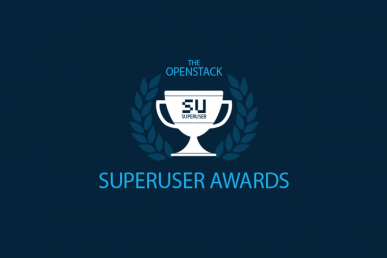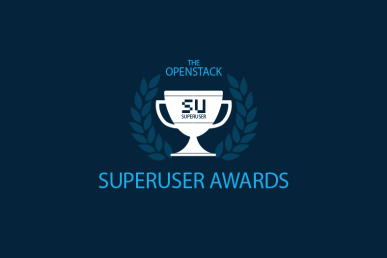It’s time for the community to determine the winner of the Superuser Award to be presented at the OpenStack Austin Summit. Based on the nominations received, the Superuser Editorial Advisory Board conducted the first round of judging and narrowed the pool to four finalists.
Now, it’s your turn.
The team from AT&T is one of the four finalists. Review the nomination criteria below, check out the other nominees and cast your vote before the deadline, Friday, April 8 at 11:59 p.m. Pacific Daylight Time. Voting is limited to one ballot per person.
How has OpenStack transformed your business?
AT&T is a legacy telco which is transforming itself by adopting virtual infrastructure and a software defined networking focus in order to compete in the market and create value for customers in the next five years and beyond.
- Virtualization and virtual network functions (VNFs) are of critical importance to the Telecom industry to address growth and agility. AT&T’s Domain 2.0 Industry Whitepaper released in 2013 outlines the need as well as direction.
- AT&T chose OpenStack as the core foundation of their cloud and virtualization strategy
- OpenStack has reinforced AT&T’s open source strategy and strengthened our dedication to the community as we actively promote and invest resources in OpenStack
- AT&T is committing staff and resources to drive the vision and innovation in the OpenStack and OPNFV communities to help drive OpenStack as the default cloud orchestrator for the Telecom industry
- AT&T as a founding member of the ETSI ISG network functions virtualization (NFV) helped drive OpenStack as the cloud orchestrator in the NFV platform framework. OpenStack was positioned as the VIM – Virtual Infrastructure Manager. This accelerated the convergence of the Telco industry onto OpenStack.
OpenStack serves as a critical foundation for AT&T’s software-defined networking (SDN) and NFV future and we take pride in the following:
- AT&T has deployed 70+ OpenStack (Juno & Kilo based) clouds globally, which are currently operational. Of the 70+ clouds 57 are production application and network clouds.
- AT&T plans 90% growth, going to 100+ production application and network clouds by the end of 2016.
- AT&T connects more than 14 million wireless customers via virtualized networks, with significant subscriber cut-over planned again in 2016
- AT&T controls 5.7% of our network resources (29 Telco production grade VNFs) with OpenStack, with plans to reach 30% by the end of 2016 and 75% by 2020.
- AT&T trained more than 100 staff in OpenStack in 2015
AT&T plans to expand to expand its community team of 50+ employees in 2016 As the chosen cloud platform OpenStack enabled AT&T in the following SDN and NFV related initiatives:
- Our recently announced 5G field trials in Austin
- Re-launch of unlimited data to mobility customers
- Launch of AT&T Collaborate a next generation communication tool for enterprise
- Provisioning of a Network on Demand platform to more than 500 enterprise customers
- Connected Car and MVNO (Mobile Virtual Network Operator)
- Mobile Call Recording
- Internally we are virtualizing our control services like DNS, NAT, NTP, DHCP, radius, firewalls, load balancers and probes for fault and performance management.
Since 2012, AT&T has developed all of our significant new applications in a cloud native fashion hosted on OpenStack. We also architected OpenStack to support legacy apps.
- AT&T’s SilverLining Cloud (predecessor to AIC) leveraged the OpenStack Diablo release, dating as far back as 2011
- OpenStack currently resides on over 15,000 VMs worldwide, with the expectation of further, significant growth coming in 2016-17
- AT&T’s OpenStack integrated Orchestration framework has resulted in a 75% reduction in turnaround time for requests for virtual resources
- AT&T Plans to move 80% of our Legacy IT into the OpenStack based virtualized cloud environment within coming years
- Uniform set of APIs exposed by OpenStack allows AT&T business units to leverage a "develop-once-run-everywhere" set of tools OpenStack helps AT&T’s strategy to begin to adopt best of the breed solutions at five 9’s of reliability for:
- NFV
- Internet-scale storage service
- SDN
- Putting all AT&T’s workloads on one common platform Deployment Automation: OpenStack modules have enabled AT&T to cost-effectively manage the OpenStack configuration in an automated, holistic fashion.
- Using OpenStack Heat, AT&T pushed rolling updates and incremental changes across 70+ OpenStack clouds. Doing it manually would be take many more people and a much longer schedule.
- Using OpenStack Fuel as a pivotal component in its cloud deployments AT&T accelerates the otherwise consuming, complex, and error-prone process of deploying, testing, and maintaining various configuration flavors of OpenStack at scale. AT&T was a major contributor towards Fuel 7.0 and Fuel 8.0 requirements. OpenStack has been a pivotal driver of AT&T’s overall culture shift. AT&T as an organization is in the midst of a massive culture shift from a Legacy Telco to a company where new skills, techniques and solutions are embraced.
OpenStack has been a key driver of this transformation in the following ways:
- AT&T is now building 50 percent of all software on open source technologies
- Allowing for the adoption of a dev ops model that creates a more unified team working towards a better end product
- Development transitioned from a waterfall to cloud-native CICD methodologies
- Developers continue to support OpenStack and make their applications cloud-native whenever possible.
How has the organization participated in or contributed to the OpenStack community?
AT&T was the first U.S. telecom service provider to sign up for and adopt the then early stage NASA-spawned OpenStack cloud initiative, back in 2011.
- AT&T has been an active OpenStack contributor since the Bexar release.
- AT&T has been a Platinum Member of the OpenStack Foundation since its origins in 2012 after helping to create its bylaws.
- Toby Ford, AVP AT&T Cloud Technology has provided vision, technology leadership, and innovation to OpenStack ecosystem as an OpenStack Foundation board member since late 2012.
- AT&T is founding member of ETSI, and OPNFV.
- AT&T has invested in building an OpenStack upstream contribution team with 25 current employees and a target for 50+ employees by the end of 2016.
- During the early years of OpenStack, AT&T brought many important use-cases to the community. AT&T worked towards solving those use-cases by leveraging various OpenStack modules, in turn encouraging other enterprises to have confidence in the young ecosystem.
- AT&T drove these following Telco-grade blueprint contributions to past releases of OpenStack:
- VLAN aware VMs (i.e. Trunked vNICs) – Support for BGP VPN, and shared volumes between guest VMs
- Complex query support for statistics in Ceilometer
- Spell checker gate job
- Metering support for PCI/PCIe per VM tenant
- PCI passthrough measurement in Ceilometer – Coverage measurement gate job
- Nova using ephemeral storage with cinder
- Climate subscription mechanism
- Access switch port discovery for bare metal nodes
- SLA enforcement per vNIC – MPLS VPNaaS
- NIC-state aware scheduling
- Toby Ford has regularly been invited to present keynotes, sessions, and panel talks at a number of OpenStack summits. For instance: Role of OpenStack in a Telco: User case study – at Atlanta Summit May 2014 – Leveraging OpenStack to Solve Telco needs: Intro to SDN/NFV – Atlanta Summit May 2014 – Telco OpenStack Roadmap Panel Talk – Tokyo Summit October 2015 – OpenStack Roadmap Software Trajectory – Atlanta Summit May 2014 – Cloud Control to Major Telco – Paris Summit November 2014.
- Greg Stiegler, assistant vice president – AT&T cloud tools & development organization represented the AT&T technology development organization at the Tokyo Summit.
- AT&T Cloud and D2 Architecture team members were invited to present various keynote sessions, summit sessions and panel talks including: – Participation at the Women of OpenStack Event – Tokyo Summit 2015 – Empower Your Cloud Through Neutron Service Function Chaining – Tokyo Summit Oct 2015 – OPNFV Panel – Vancouver Summit May 2015 – OpenStack as a Platform for Innovation – Keynote at OpenStack Silicon Valley – Aug 2015 – Taking OpenStack From Zero to Production in a Fortune-500 – Tokyo Summit October 2015 – Operating at Web-scale: Containers and OpenStack Panel Talk – Tokyo Summit October 2015 * AT&T strives to collaborate with other leading industry partners in the OpenStack ecosystem. This has led to the entire community benefiting from AT&T’s innovation.
- Margaret Chiosi gives talks worldwide on AT&T’s D2.0 vision at many Telco conferences ranging from Optics (OFC) to SDN/NFV conferences advocating OpenStack as the de-facto cloud orchestrator.
- AT&T Entertainment Group (DirecTV) architected multi-hypervisor hybrid OpenStack cloud by designing Neutron ML2 plugin. This innovation helped achieve integration between legacy virtualization and OpenStack.
-
AT&T is proud to drive OpenStack adoption by sharing knowledge back to the OpenStack community in the form of these summit sessions at the upcoming Austin summit:
- Telco Cloud Requirements: What VNFs Are Asking For
- Using a Service VM as an IPv6 vRouter
- Service Function Chaining
- Technology Analysis Perspective
- Deploying Lots of Teeny Tiny Telco Clouds
- Everything You Ever Wanted to Know about OpenStack At Scale
- Valet: Holistic Data Center Optimization for OpenStack
- Gluon: An Enabler for NFV
- Among the Cloud: Open Source NFV + SDN Deployment
- AT&T: Driving Enterprise Workloads on KVM and vCenter using OpenStack as the Unified Control Plane
- Striving for High-Performance NFV Grid on OpenStack. Why you, and every OpenStack community member should be excited about it
- OpenStack at Carrier Scale
- AT&T is the "first to market" with deployment of OpenStack supported carrier-grade Virtual Network Functions. We provide the community with integral data, information, and first-hand knowledge on the trials and tribulations experienced deploying NFV technology.
- AT&T ranks in the top 20 percent of all companies in terms of upstream contribution (code, documentation, blueprints), with plans to increase this significantly in 2016.
- Commits: 1200+
- Lines of Code: 116,566
- Change Requests: 618
- Patch Sets: 1490
- Draft Blueprints: 76
- Completed Blueprints: 30
- Filed Bugs: 350
- Resolved Bugs: 250
What is the scale of the OpenStack deployment?
- AT&T’s OpenStack based AIC is deployed at 70+ sites across the world. Of the 70+ 57 are production app and network clouds.
- AT&T plans 90% growth, going to 100+ production app and network clouds by end of 2016.
- AT&T connects more than 14 million of the 134.5 million wireless customers via virtualized networks with significant subscriber cutover planned again in 2016
- AT&T controls 5.7% of our network resources (29 Telco production grade VNF) with a goal of high 80s by end of 2016) on OpenStack.
- Production workloads also include AT&T’s Connected Car, Network on Demand, and AT&T Collaborate among many more.
How is this team innovating with OpenStack?
- AT&T and AT&T Labs are leveraging OpenStack to innovate with Containers and NFV technology.
- Containers are a key part of AT&Ts Cloud Native Architecture. AT&T chairs the Open Container Initiative (OCI) to drive the standardization around container formats.
- AT&T is leading the effort to improve Nova and Neutron’s interface to SDN controllers.
- Margaret Chiosi, an early design collaborator to Neutron, ETSI NFV, now serves as President of OPNFV. AT&T is utilizing its position with OPNFV to help shape the future of OpenStack / NFV. OpenStack has enabled AT&T to innovate extensively.
The following recent unique workloads would not be possible without the SDN and NFV capabilities which OpenStack enables:
- Our recent announcements of 5G field trials in Austin
- Re-launch of unlimited data to mobility customers
- Launch of AT&T Collaborate
- Network on Demand platform to more than 500 enterprise customers
- Connected Car and MVNO (Mobile Virtual Network Operator)
- Mobile Call Recording New services by AT&T Entertainment Group (DirecTV) that would use OpenStack based cloud infrastructure in coming years:
- NFL Sunday Ticket with up to 8 simultaneous games
- DirecTV Streaming Service Without Need For satellite dish
In summary – the innovation with OpenStack is not just our unique workloads, but also to support them together under the same framework, management systems, development/test, CI/CD pipelines, and deployment automation toolset(s).
Who are the team members?
- AT&T Cloud and D2 architecture team
- AT&T Integrated Cloud (AIC) Members: Margaret Chiosi, distinguished member of technical staff, president of OPNFV; Toby Ford, AVP – AT&T cloud technology & D2 architecture – strategy, architecture & pPlanning, and OpenStack Foundation Board Member; Sunil Jethwani – director, cloud & SDN architecture, AT&T Entertainment Group; Andrew Leasck – director – AT&T Integrated cloud development; Janet Morris – director – AT&T integrated cloud development; Sorabh Saxena, senior vice president – AT&T software development & engineering organization; Praful Shanghavi – director – AT&T integrated cloud development; Bryan Sullivan – director member of technical staff; Ryan Van Wyk – executive director – AT&T integrated cloud development.
- AT&T’s project teams top contributors: Paul Carver, Steve Wilkerson, John Tran, Joe D’andrea, Darren Shaw.
Cast your vote for one of the nominees before the deadline, Friday, April 8 at 11:59 p.m. Pacific Daylight Time
Voting is limited to one ballot per person.
Cover Photo // CC BY NC
- Demystifying Confidential Containers with a Live Kata Containers Demo - July 13, 2023
- OpenInfra Summit Vancouver Recap: 50 things You Need to Know - June 16, 2023
- Congratulations to the 2023 Superuser Awards Winner: Bloomberg - June 13, 2023

)










